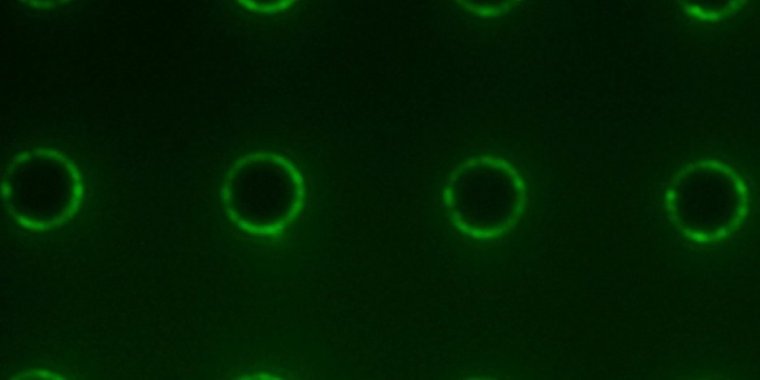| News / Science News |
Seeing concentrations of toxins with the naked eye
Researchers at Harvard University and other institutions have developed a fast and cost-effective method to test liquids for a ubiquitous family of chemical compounds known as amphiphiles, which are used to detect diseases such as early-stage tuberculosis and cancer as well as toxins in drugs, food, medical devices and water supplies.

Fluorescence image of amphiphiles concentrated at the edges of micropillars on a microstructured surface. Photo: Aizenberg Lab/Harvard SEAS
Today's gold standard for testing for endotoxins, a common type of amphiphile that can contaminate water and cause severe illness and death, requires the use of compounds only found in the blood of horseshoe crabs — making the process expensive and unsustainable.
Cheaper alternatives are not sensitive enough to detect amphiphiles at meaningful levels.
The new test, developed by Joanna Aizenberg of Harvard and Xiaoguang Wang of The Ohio State University, uses rolling droplets on microstructured surfaces to detect amphiphiles at ultralow concentrations.
The team demonstrated the technique to detect levels of pathogenic amphiphilic endotoxins in water, compounds that can be toxic even at extremely low concentrations.
"Our surfaces provide a rapid and portable method of detecting amphiphiles in droplets that you can see with your eyes," said Aizenberg. "No other methods allow detection at the low levels that we're seeing in our tests, without using expensive or sophisticated equipment."
The researchers also developed a model to predict how different amphiphile compounds at different concentrations would interact with the structured surfaces.
By changing the size, shape and distance between pillars, as well as the molecular coating, the surfaces can be tuned to detect specific types of amphiphiles at specific concentrations.
"Our method is applicable to any kind of amphiphile," said Wang. "We are already detecting endotoxins at levels that are relevant for water quality testing, but the test can be further optimized to detect even lower concentrations." (U.S. National Science Foundation)
YOU MAY ALSO LIKE





